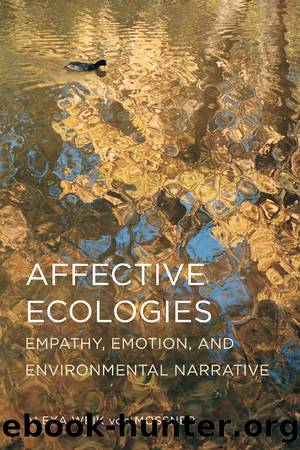Affective Ecologies by Alexa Weik von Mossner

Author:Alexa Weik von Mossner
Language: eng
Format: epub
Publisher: The Ohio State University
Published: 2017-07-15T00:00:00+00:00
FEELING THE RISK: EXPERIENCING ECO-CATASTROPHE IN THE DYSTOPIAN NOVEL
As a speculative mode of narration, science fiction imagines possible alternative and future worlds that can be either utopian or dystopian in nature. It is “a fictive practice” that, in the words of Tom Moylan, “has the formal potential to re-envision the world in ways that generate pleasurable, probing, and potentially subversive responses in its readers” (2000, 4). Not least because of their investment in the building of alternative worlds, a good number of science fiction writers have concerned themselves with environmental issues. As Heise has pointed out, “science fiction is one of the genres that have most persistently and most daringly engaged environmental questions and their challenge to our vision of the future” (1999, 1097).18 Arguably, the earliest science fiction novels that focus on climate change date all the way back to the 1960s. Although the scenarios they evoke are not anthropogenic in nature, books such as Brian Aldiss’s Hothouse (1962), J. G. Ballard’s The Drowned World (1962), and Philip K. Dick’s The Three Stigmata of Palmer Eldritch (1965) all envision a radically different planet Earth that is the result of an increase in surface temperature. The drastically changed ecological worlds they depict, however, are driven by an altered radiation of the sun and thus by factors that lie beyond the agential reach of humans. It is only since the late 1990s that anthropogenic climate change becomes a topic in dystopian American fiction, from Norman Spinrad’s Greenhouse Summer (1999) and T. C. Boyle’s A Friend of the Earth (2000) to Michael Crichton’s State of Fear (2004) and Kim Stanley Robinson’s Science in the Capital series (2004, 2005, 2007). More recent publications include Steven Amsterdam’s Things We Didn’t See Coming (2009), Dale Pendell’s The Great Bay (2010), Nathaniel Rich’s Odds Against Tomorrow (2013), and Paolo Bacigalupi’s The Water Knife (2015).19
All of these climate change novels deal with what Mayer calls “narrative[s] of catastrophe” (2014, 26), and yet they are also, and at the same time, concerned with complex risk scenarios and therefore with the anticipation of even worse catastrophes.20 Oreskes and Conway suggest that Robinson’s trilogy is particularly visionary when it comes to the risks that climate change might pose to Americans. As literary scholars Adam Trexler and Adeline Johns-Putra state in their overview of climate change in Anglophone literature, “Robinson has emerged as science fiction’s most important writer to deal explicitly with the problem of climate change, not simply as the premise for an other-worldly setting but as a social, cultural, and political phenomenon and problem, requiring unusual methods of characterization and plot” (2011, 187). I will engage with Robinson’s fiction in the next chapter, but for now I want to focus my attention on another novel that is interesting for its vivid evocation of climate risk and related catastrophes: Boyle’s A Friend of the Earth. The novel is set in a near-future California, one that at the time of my writing is only ten years away. As Nils Zumbansen and
Download
This site does not store any files on its server. We only index and link to content provided by other sites. Please contact the content providers to delete copyright contents if any and email us, we'll remove relevant links or contents immediately.
| Ancient & Classical | Arthurian Romance |
| Beat Generation | Feminist |
| Gothic & Romantic | LGBT |
| Medieval | Modern |
| Modernism | Postmodernism |
| Renaissance | Shakespeare |
| Surrealism | Victorian |
4 3 2 1: A Novel by Paul Auster(11034)
The handmaid's tale by Margaret Atwood(6837)
Giovanni's Room by James Baldwin(5872)
Big Magic: Creative Living Beyond Fear by Elizabeth Gilbert(4718)
Asking the Right Questions: A Guide to Critical Thinking by M. Neil Browne & Stuart M. Keeley(4566)
On Writing A Memoir of the Craft by Stephen King(4205)
Ego Is the Enemy by Ryan Holiday(3982)
Ken Follett - World without end by Ken Follett(3968)
The Body: A Guide for Occupants by Bill Bryson(3789)
Bluets by Maggie Nelson(3705)
Adulting by Kelly Williams Brown(3663)
Guilty Pleasures by Laurell K Hamilton(3578)
Eat That Frog! by Brian Tracy(3508)
White Noise - A Novel by Don DeLillo(3430)
The Poetry of Pablo Neruda by Pablo Neruda(3358)
Alive: The Story of the Andes Survivors by Piers Paul Read(3303)
The Bookshop by Penelope Fitzgerald(3221)
The Book of Joy by Dalai Lama(3212)
Fingerprints of the Gods by Graham Hancock(3206)
